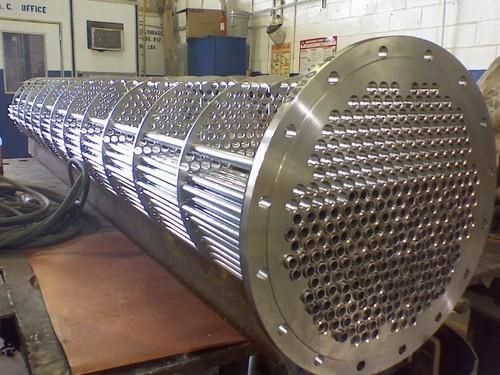Shell and tube heat exchanger
Paint Machinery
Chemical Machinery
Resin Manufacturing Plants

he shell and tube heat exchanger is made up of a bundle of parallel heat exchanger tubes held in place with tube sheets and placed into a shell. The heat exchange always takes place between two fluids through the heat exchanger tube wall. There are quite a variety of flow options for shell and tube heat exchangers, as discussed in the following sections. In all of the configurations for shell and tube heat exchangers, one fluid passes through the tubes (the tube side fluid) and the other passes through the shell (the shell side fluid). The choice of shell and tube heat exchanger configuration affects the overall heat transfer coefficient and thus also affects the rate of heat transfer and the heat exchanger tube surface area needed.
he two fluids that are exchanging heat in a shell and tube heat exchanger are referred to as the tube side fluid (which goes through the heat exchanger inside the tubes) and the shell side fluid (which goes through the heat exchanger in the shell, outside the tubes).
Important components of a shell and tube heat exchanger (in addition to the obviously important tubes and shell) are the tube sheets, baffles, end channels for the tube side fluid, and inlet & outlet nozzles for both the shell side fluid and the tube side fluid. These various components are shown in the diagram of a straight tube, two pass, shell and tube heat exchanger at the left. As shown in the diagram, the tube sheets serve to hold the tubes in place in a "tube bundle" (see diagrams in next section), and also can serve as baffles to create turbulence and a more consistent residence time for the shell side fluid. The end channels distribute the tube side fluid and create either a transition to the outlet nozzle or a means to send the tube side fluid back to the other end of the heat exchanger, as in the diagram above.

